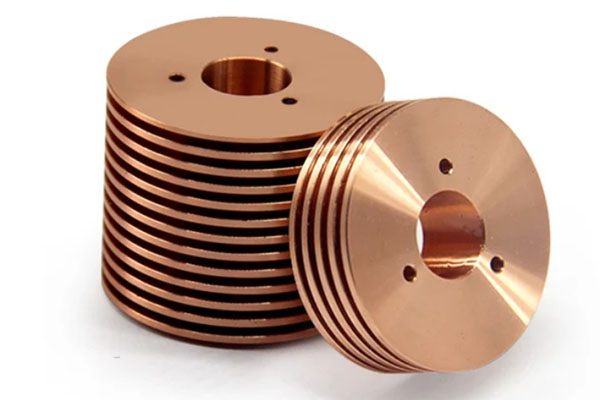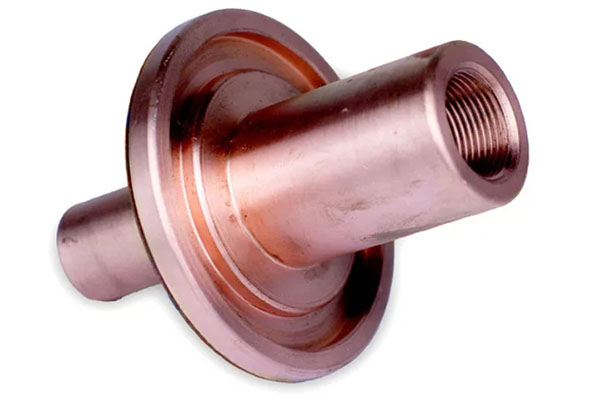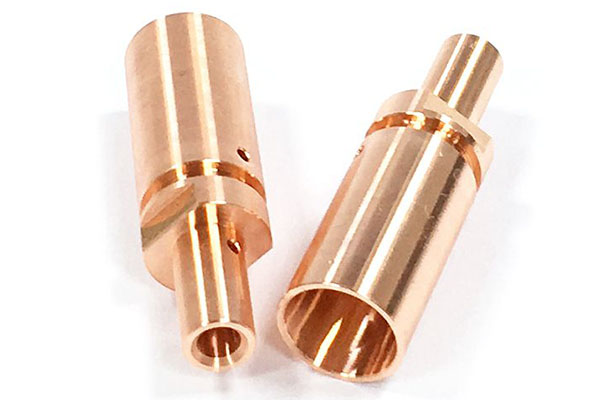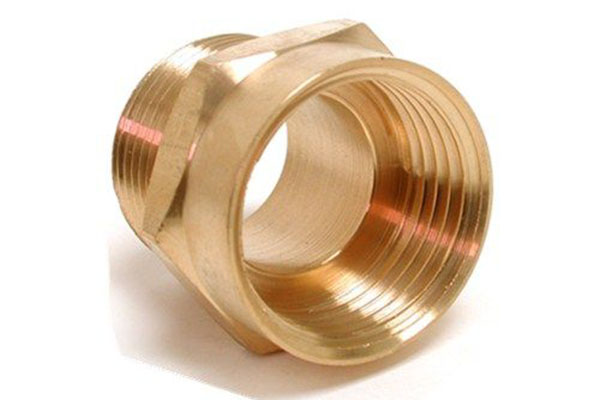Materiais de peças metálicas de cobre
Copper is a metal with excellent physical and chemical properties. It's well-known for its great ability to conduct electricity and heat, plus it's easy to shape and resistant to rust. Because of these qualities, copper is used in many different areas. Pure copper, which is nearly 100% copper, is the most common type. It's great at conducting electricity and heat, making it popular in the electrical and electronics industries. You'll find it in things like wires, cables, electronic parts, and transformers.
Copper isn't just used as it is; it's also mixed with other metals to make alloys like brass, bronze, and white copper. These mixes are strong, don't corrode easily, and resist wear and tear, making them perfect for various uses.
In the world of electrical engineering, copper is everywhere. Its top-notch conductivity means it's the go-to material for making wires, cables, and other electrical components. Copper wires inside cables have low resistance, don't get hot easily, and allow electricity to flow smoothly. Plus, copper is a key ingredient in electronic devices like circuit boards and integrated circuits.
When it comes to building things, copper shines too. It doesn't rust when exposed to the elements, so it's often used for roofing, walls, and decorative features on buildings. The unique color and shine of copper can make a building look nicer. And since copper has antibacterial properties, it helps keep buildings cleaner by stopping bacteria from growing.
The manufacturing sector relies heavily on copper as well. It's flexible enough to be rolled out, pulled into wires, or shaped into various forms, making it ideal for creating all sorts of parts and machinery. Cars use lots of copper parts, such as engine components, brake systems, and air conditioning units. Copper is also crucial in shipbuilding, aerospace, and mechanical engineering.
Even in healthcare and biology, copper plays a vital role. Medical tools, wires, and tubes often contain copper because of its natural ability to fight germs. This makes it useful for covering medical equipment and materials to help prevent infections. In biological research, copper acts as a stable marker and catalyst to speed up reactions.
In short, copper's special traits make it essential in today's industries. As technology advances and industries grow, the need for copper will only increase, promising even broader applications for this versatile metal.
Peças de metal de cobre que fazem o serviço
Be good at product structure optimization and greatly reduce the cost of Copper Metal Parts Materials

Design da peça
Design Estético e Estrutural

Fabricação de moldes
Design, Confirmação de Facilidade de Manufatura

Produção de Produto
Equipamento de Alta Velocidade Importado

Montagem do Produto
Matéria-Prima, Inspeção e Montagem
Model classification of Copper Metal Parts Materials
Ordinary brass: such as H62, H65, etc., this type of brass is mainly used for general mechanical parts, daily necessities, and electrical equipment.
Lead brass: such as HPb59-1, suitable for parts that require high machinability, such as clock parts and automotive parts.
Manganese brass, such as HMn58-2, has high strength and good corrosion resistance, suitable for ship parts and chemical machinery.
Silicon brass, such as HSi80-3, has high strength and good elasticity, making it suitable for corrosion-resistant parts.
Tin brass, such as HSn70-1, has high corrosion resistance and good cold workability, making it suitable for ships and coastal facilities.
Iron brass: such as HFe59-1-1, has high strength and good machinability, suitable for structural and wear-resistant parts.
Níquel brass, such as HNi65-5, has excellent corrosion resistance and high toughness, making it suitable for the shipbuilding and power industries.
Aluminum brass, such as HAi60-1-1, has high strength and good corrosion resistance, making it suitable for important structural components.
Tin bronze, such as QSn4-3, has high strength, hardness, and wear resistance, and is used for bearings and gears.
Phosphorus bronze: such as QSN6.5-0.1, has good corrosion resistance and wear resistance, and is commonly used in springs and screws.
Beryllium bronze, such as QBe2.0, has high strength and hardness, suitable for precision springs and electrical contact components. The commonly used Beryllium bronze grades include C17200, C17300, and C17000, which are high-strength deformation alloys; C17500/C17510 is a high conductivity deformation alloy; BeA-275C/BeA-20C is a high-strength cast alloy; BeA-10C/BeA-50C are high conductivity casting alloys.
Silicon bronze, such as QSi3-1, has good corrosion resistance and heat resistance, and is used for components and artworks working in seawater.
Manganese bronze, such as QMn5, has high strength and good anti friction properties, suitable for ship bearings and shaft sleeves.
Lead bronze: such as QPb30, suitable for low-speed sliding bearings.
Tellurium bronze: such as QFe3.5-0.5-0.5, has good elasticity and fatigue limit, suitable for spring components.
Cadmium bronze, such as QCd1.0, has high strength and good conductivity, making it suitable for electrical contact components.
Simple white copper, such as BFe5-1.5, has good magnetic and thermoelectric properties and is used in electronic instruments and meters.
Complex white copper, such as BMn3-12, has good electrical resistivity and thermoelectric properties, and is used for thermocouples and heating elements.
Zinco white copper, such as BZn15-20, has high strength and good corrosion resistance, and is used in medical devices and precision mechanical parts.
Aluminum white copper, such as BA13-3, has high strength and good corrosion resistance, and is used for ship propellers and pump shafts.
Machining Process of Copper Metal Parts
There are many ways to process copper materials, includingThere are many ways to process copper materials, including, drawing, and forging Each method has its own unique features and is used for different product needs and industrial applications.
Rolling involves using a rolling mill to apply pressure to the copper material, shaping it into sheets or strips. This method is often used to make copper foil, copper plates, and copper strips, which are widely used in the electronics industry and architectural decoration.
Extruding applies pressure to a copper billet, forcing it through a die to form tubes or profiles. This process is suitable for producing complex cross-sectional copper products, such as radiator tubes and condenser tubes.
Drawing uses a drawing machine to pull copper rods or tubes into thinner wires or tubes. The drawing process can enhance the strength and surface smoothness of copper materials, making it ideal for manufacturing precision copper wires and tubes.
Forging involves applying impact or pressure to the copper material with a forging press to plastically deform it into the desired shape and size. Forging increases the density and mechanical properties of copper materials, making it suitable for producing complex parts like gears and bearings.
In summary, copper materials play an indispensable role in modern industry due to their unique physical and chemical properties. Whether in electronics, construction, or manufacturing, copper provides key solutions. As technology advances and industries grow, the demand for copper will continue to rise, promising a broader application future for copper materials.
FAQ About Copper Metal Parts
Copper parts play a crucial role in various engineering applications due to their excellent electrical conductivity, thermal conductivity, and malleability. In the realm of electrical engineering, they're often found in wiring, connectors, and circuit boards, ensuring efficient transmission of electricity. Additionally, copper's ability to withstand high temperatures makes it ideal for use in heat exchangers and cooling systems. Its corrosion resistance also means it's frequently utilized in plumbing and HVAC systems. Overall, copper parts are indispensable across numerous sectors including electronics, automotive, and construction.
Maintaining copper parts is essential to extend their lifespan and keep them functioning efficiently. Firstly, regular inspections can help identify any signs of wear or corrosion early on. For cleaning, a mixture of mild soap and water usually does the trick for general grime. However, for tougher stains or tarnish, a paste made from baking soda and water works wonders. Apply the paste, gently scrub with a soft cloth, then rinse thoroughly. It's important to dry the parts completely after cleaning to prevent moisture-induced corrosion. Also, applying a thin layer of protective coating, like a specialized copper polish, can provide an extra barrier against environmental factors.
There are several copper alloys, each tailored for specific applications based on their unique properties. For instance, brass, an alloy of copper and zinc, is prized for its strength and corrosion resistance, making it perfect for musical instruments and decorative items. Another common alloy is bronze, which combines copper with tin or other elements, offering enhanced hardness and wear resistance, ideal for bearings and gears. Cupronickel, an alloy of copper and nickel, boasts excellent resistance to seawater corrosion, making it suitable for marine applications. Each of these alloys brings something special to the table, allowing engineers to select the best fit for their needs.
Absolutely, copper parts can be recycled, and the process is both straightforward and environmentally friendly. When copper parts reach the end of their life cycle, they are collected and sorted based on their purity and type. The recycling begins with shredding the materials into smaller pieces, followed by melting them down in a furnace at high temperatures. This melting process separates the copper from any impurities or other metals. The molten copper is then purified further if necessary and cast into new shapes or forms, ready for reuse. Recycling copper not only conserves natural resources but also reduces energy consumption compared to producing new copper from ore.
Copper stands out among metals for several reasons, making it the preferred choice for many applications. Its superior electrical conductivity means it's unmatched in transmitting electric currents with minimal loss, crucial for power generation and distribution systems. Thermally, copper excels too, efficiently conducting heat away from sensitive components, enhancing performance and longevity. Moreover, copper's natural resistance to corrosion ensures durability even in harsh environments. These combined attributes make copper indispensable where reliability and efficiency are paramount, outshining alternatives like aluminum or steel in specific scenarios.
Ensuring the quality and purity of copper parts before buying is vital for achieving optimal performance and longevity in your projects. Start by examining the part closely; high-quality copper should have a consistent color without any discoloration or spots indicating impurities. You can also perform a simple magnet test; pure copper isn't magnetic, so if a magnet sticks to it, it likely contains other metals. For more precise assessment, ask for material certification or conduct a火花测试 (spark test), wherein grinding the copper creates a spark that reveals its composition based on color. Always purchase from reputable suppliers who provide detailed specifications and guarantees of proving the authenticity and quality of their copper parts.